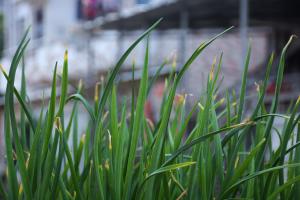Introduction
Tomato plants are known for their vibrant green leaves, but sometimes, we can observe white lines on them. This can be a cause for concern for gardeners and farmers as it may indicate an underlying problem affecting the health of the plant. In this article, we will discuss the various reasons that can cause white lines on tomato plant leaves.
Viral Infections
One of the most common causes of white lines on tomato plant leaves is a viral infection. Some viruses, like the Tomato Mosaic Virus (ToMV) and the Tomato Spotted Wilt Virus (TSWV), can cause discoloration on the leaves, resulting in white lines. These viruses are usually transmitted through infected seeds, soil, or by insects like aphids and whiteflies. Once infected, the plant's growth can be stunted, and the yield can be significantly reduced. There's no cure for viral infections, so prevention is key. Growers should use disease-free seeds, and practice proper sanitation methods when handling plants and tools. Insecticides may also help control virus-transmitting insects.
Fungal Infections
Fungal infections can also lead to white lines on tomato plant leaves. Fungi like powdery mildew and septoria leaf spot can cause discoloration on the leaves, resulting in white lines or patches. Powdery mildew, in particular, can infect the leaves, stems, and fruits, causing significant damage to the plant. Poor air circulation, high humidity, and damp conditions can exacerbate fungal infections. To control fungal infections, growers should promote good airflow and avoid overhead irrigation. Applying fungicides regularly can also help prevent fungal infections.
Nutrient Deficiencies
White lines on tomato plant leaves can also be caused by nutrient deficiencies. For instance, calcium deficiencies can cause white streaks or blotches to appear on leaf edges. Other nutrients like iron or magnesium deficiencies can also cause leaf discolorations in varying shades of white, yellow, or brown. Nutrient deficiencies can be prevented by testing and maintaining the soil's pH and nutrient levels. Regular fertilization and amendments can help ensure that the plant gets adequate nutrients to support healthy growth and development.
Environmental Factors
Environmental factors can also contribute to white lines on tomato plant leaves. High temperatures, strong winds, and excessive moisture can cause physical damage to the leaves, resulting in white or yellowish lines. Sometimes, if the plant is exposed to direct sunlight for prolonged periods, the leaves can get sunscalded, leading to white or brownish lines. Growers should take care to protect the plants from adverse environmental conditions by providing shade or using windbreaks. Adequate watering and mulching can also help regulate soil moisture levels.
Pesticide Use
Lastly, using pesticides can also cause white lines or spots on tomato plant leaves. Sometimes, if pesticides are applied in high amounts or sprayed during unfavorable weather conditions, they can cause chemical burns on the plant's leaves, resulting in white or yellowish lines. This can be prevented by following the pesticide label instructions, using recommended dosages, and spraying during favorable weather conditions. It's also important to note that some pesticides can be harmful to beneficial insects, like pollinators and predatory insects, that play a crucial role in maintaining ecosystem balance.
Conclusion
White lines on tomato plant leaves can be caused by various factors, including viral and fungal infections, nutrient deficiencies, environmental factors, and pesticide use. Identifying the underlying cause is essential to develop an appropriate treatment plan. Growers should also practice good hygiene, use preventive measures, and follow best management practices to protect their crops and maintain plant health.

 how many times do yo...
how many times do yo... how many planted tre...
how many planted tre... how many pine trees ...
how many pine trees ... how many pecan trees...
how many pecan trees... how many plants comp...
how many plants comp... how many plants can ...
how many plants can ... how many plants and ...
how many plants and ... how many pepper plan...
how many pepper plan...































